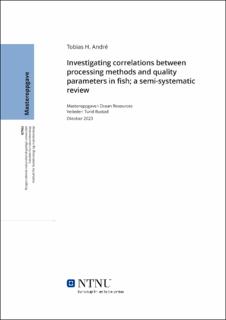| dc.description.abstract | In this thesis, chilling and freezing was investigated to determine three things. Firstly, to determine what processing technologies were used. Secondly, to determine what quality parameters were measured. And thirdly, to determine if there were any correlations between the reported processing methods and measured quality parameters. To do this, 41 studies were chosen using a semi-systematic approach. Groups of processing methods were generalised into freezing, chilling and superchilling based on the technology used. Quality parameters were grouped by how they measured the parameters. Therefore, there was four groups of quality parameters; physiochemical (quality parameters measured by physical methods like water contents and pH), chemical (parameters measured by chemical methods like chemical composition and biogenic amines), sensory (quality measured by sensory/organoleptic methods like taste and smell) and microbial (quality parameters measured using microbiological methods usually showing presence of microorganisms). The included studies were first categorised by what processing method they used and what quality parameters were measured. Afterwards a synthesis of both processing methods and quality parameters was made to try to determine correlations. The results show that many cases used freezing as their processing method and mostly measured chemical quality parameters. The second most common processing method and quality parameter was freezing and physiochemical quality parameters respectively with only slightly fewer cases each. Superchilling, sensory and microbial quality parameters were all not often measured. Most of the included studies measured two quality parameters and one processing method. Also, there are three different ways to describe the results of processing methods; as a comparative study between two or more processing methods, comparative study of two or more types of processing methods (comparing cryogenic and air blast freezers) or a documentation of the effects of the processing methods on the product. Due to large internal variations, it seems like no correlation could be found outside of strictly general terms. As freezing and chemical were most common and chilling and physiochemical second most common, we can say that in the included study, the majority used freezing and/or chilling as their processing methods and physiochemical and/or chemical as the measured quality parameters. A method to narrow down could give more specific results, but the intention of a review needs to be taken into consideration so as to not compromise the review. Future studies following a similar method should attempt to narrow down to one quality parameter group and use different processing methods. | |
